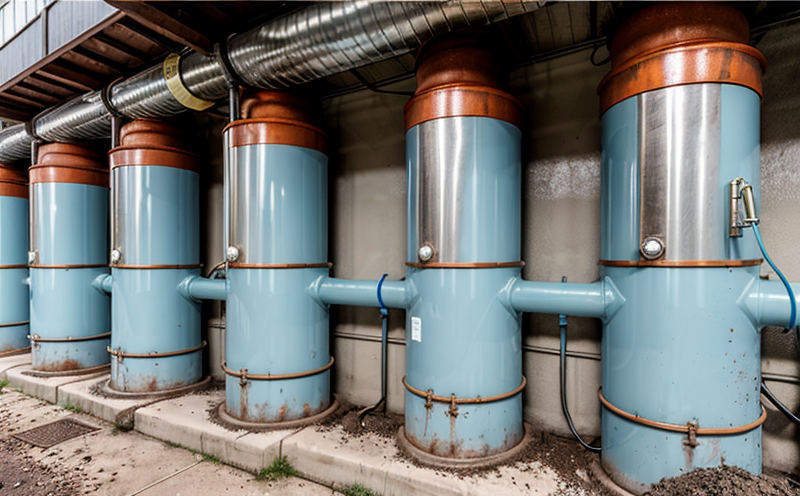ASTM G217 Stress Cracking Test in Water Systems
The ASTM G217 Stress-Cracking Test is a critical procedure used to evaluate the susceptibility of materials, particularly metals and alloys, to stress corrosion cracking (SCC) under specific conditions. SCC can occur when a material is subjected to a tensile stress while exposed to an aqueous environment containing specific ions such as chloride or bromide.
The test is essential for industries where water quality and system integrity are paramount, including water treatment facilities, power generation plants, and chemical manufacturing units. It helps in ensuring the longevity of critical infrastructure by identifying potential weaknesses before they lead to failures that could compromise safety and operational efficiency.
For this test, specimens are immersed in a solution containing the specific ions under conditions designed to simulate real-world environments. The test evaluates how materials respond to these conditions over time, providing valuable insights into their durability and reliability.
The ASTM G217 procedure is standardized to ensure consistency across different laboratories and testing facilities. It specifies the type of material to be tested, the solution composition, temperature, duration of exposure, and other critical parameters. This standardization ensures that results are comparable and reliable, facilitating informed decision-making in material selection and system design.
Understanding the ASTM G217 test is crucial for quality managers, compliance officers, R&D engineers, and procurement teams who need to ensure that their materials meet stringent environmental requirements. By identifying potential SCC issues early on, these professionals can take proactive measures to enhance product performance and extend service life.
Quality and Reliability Assurance
The ASTM G217 Stress-Cracking Test plays a pivotal role in maintaining the quality and reliability of materials used in water systems. By subjecting specimens to controlled environmental conditions, this test helps identify materials prone to SCC, ensuring that only reliable and durable products are selected for critical applications.
During the test, the integrity of the material is monitored over time, allowing engineers and technicians to assess its resistance to cracking under stress in a water environment. This information is invaluable for designing systems that can withstand harsh conditions without compromising safety or functionality.
The standardized nature of ASTM G217 ensures consistency across different testing facilities, making it easier to compare results and establish best practices. Laboratories adhering to this standard are better equipped to meet regulatory requirements and industry standards, thereby enhancing overall quality control processes.
For procurement teams, understanding the ASTM G217 test can help in specifying materials that meet stringent performance criteria. By choosing suppliers who conduct such tests, organizations ensure they receive high-quality products that are less likely to fail under operational stress. This proactive approach not only improves system reliability but also reduces maintenance costs and potential downtime.
In summary, the ASTM G217 Stress-Cracking Test is an essential tool for ensuring the longevity of materials in water systems. By identifying SCC-prone materials early on, it enables engineers to design more robust systems that can operate reliably under challenging conditions.
Competitive Advantage and Market Impact
- Enhanced Product Reliability: By identifying potential SCC issues early, companies can develop products with superior durability, reducing the risk of failures in critical applications.
- Informed Decision-Making: The test results provide valuable data that influence material selection and system design, leading to more efficient and effective solutions.
- Regulatory Compliance: Adhering to ASTM G217 ensures compliance with international standards, which is crucial for operating in competitive global markets.
- Cost Savings: Early identification of SCC-prone materials prevents costly repairs and replacements down the line, ultimately saving money.
The ASTM G217 Stress-Cracking Test is a cornerstone of quality assurance efforts. It provides a clear pathway to enhance product reliability and durability, ensuring that materials perform consistently under challenging environmental conditions. This capability not only sets companies apart in competitive markets but also contributes significantly to operational efficiency and safety.
Use Cases and Application Examples
| Industry Sector | Application Example | Test Parameters |
|---|---|---|
| Water Treatment Facilities | Detecting SCC in pipeline materials to ensure long-term integrity. | - Specimen type: Stainless steel |
| Power Generation Plants | Evaluating condenser tubes for resistance to chloride-induced SCC. | - Solution composition: 3% sodium chloride |
| Chemical Manufacturing Units | Assessing reactor internals for susceptibility to SCC in harsh environments. | - Temperature: 60°C |
| Industry Sector | Application Example | Test Parameters |
|---|---|---|
| Pharmaceutical Manufacturing Plants | Evaluating container closure integrity for drug product containers. | - Exposure time: 96 hours |
| Beverage Industry | Detecting SCC in bottling and packaging equipment to ensure product safety. | - Specimen type: Aluminum alloys |
| Oil & Gas Sector | Evaluating downhole tubing for resistance to chloride-induced SCC under high pressure. | - Solution concentration: 5% hydrochloric acid |
The ASTM G217 Stress-Cracking Test is widely used across various industries, particularly those involving water systems. By identifying materials prone to stress corrosion cracking early in the development process, companies can optimize their product design and improve system reliability.





